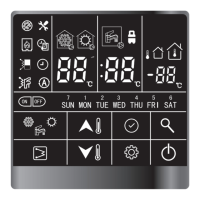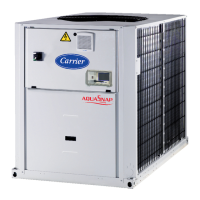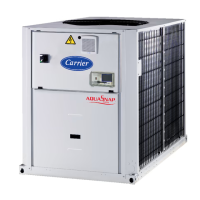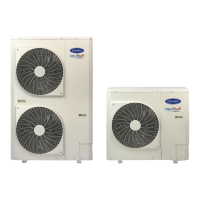43
14.4 - Supplementary electric resistance
heaters
To permit staging of the capacity reduction of the heat pump at
low ambient temperatures, as shown in the diagram below, it is
possible to install supplementary electric heaters in the leaving
water line. Their capacity can compensate for the capacity drop
of the heat pump.
These heaters can be controlled via an electronic card mounted
on a board (option).
Four outputs are available to control the heater contactors (not
supplied with the board), permitting gradual compensation of the
heat pump capacity reduction.
These outputs are congurable to obtain a choice of two, three or
four stages. The last stage will only be activated after a shut-down
of the heat pump following a fault con-dition (safety device).
In the diagram below “example of additional electric heaters” the
capacity of the four heaters is the same as the capacity of the heat
pump at 7°C outdoor air temperature.
This requires only a 400 V-3 ph-50 Hz power supply source, as
well as a connection to the unit via a communication bus.
For the required conguration of the stages consult the 30RB/RQ
Touch Pilot Junior Control IOM.
Typical accessory installation diagram
Legend
1 Electric heater power supply 400 V-3 ph-50 Hz
2 Accessory control board for four additional electric heaters
3 Internal communication bus
4 Heater stage control contactors
5 Power supply for additional heaters
6 Supplementary electric resistance heaters
Example of additional electric heaters
Outdoor air temperature, °C
Pump capacity, %
1
A
2
3
4
B
120
100
80
60
40
20
0
-15 -10 -5 05 10 15
1
1
2
C
Legend
1 Stage 1
2 Stage 2
3 Stage 3
4 Stage 4
A Heat pump capacity variation as a function of the air temperature
B Building thermal load
C Balance point between the capacity supplied by the heat pump and the thermal load of the building
Operating range, in which the heat pump capacity is lower than the building thermal load
Operating range, in which the heat pump capacity is higher than the building thermal load
14 - START-UP

